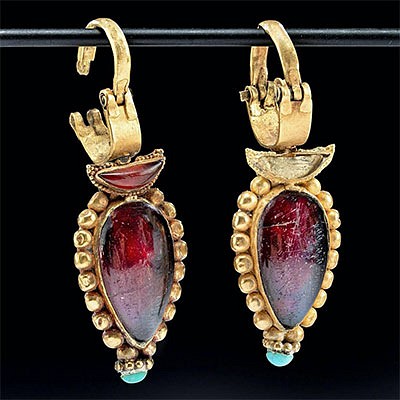2 Greek Archaic & Apulian Pottery Fragments
Lot 69a
About Seller
Artemis Gallery
686 S Taylor Ave, Ste 106
Louisville, CO 80027
United States
Selling antiquities, ancient and ethnographic art online since 1993, Artemis Gallery specializes in Classical Antiquities (Egyptian, Greek, Roman, Near Eastern), Asian, Pre-Columbian, African / Tribal / Oceanographic art. Our extensive inventory includes pottery, stone, metal, wood, glass and textil...Read more
Categories
Estimate:
$400 - $600
Absentee vs Live bid
Two ways to bid:
- Leave a max absentee bid and the platform will bid on your behalf up to your maximum bid during the live auction.
- Bid live during the auction and your bids will be submitted real-time to the auctioneer.
Bid Increments
| Price | Bid Increment |
|---|---|
| $0 | $25 |
| $300 | $50 |
| $1,000 | $100 |
| $2,000 | $250 |
| $5,000 | $500 |
| $10,000 | $1,000 |
| $20,000 | $2,500 |
| $50,000 | $5,000 |
| $100,000 | $10,000 |
| $200,000 | $20,000 |
About Auction
By Artemis Gallery
Nov 11, 2021
Set Reminder
2021-11-11 12:00:00
2021-11-11 12:00:00
America/New_York
Bidsquare
Bidsquare : It's a Small World | Diminutive Artifacts
https://www.bidsquare.com/auctions/artemis-gallery/its-a-small-world-diminutive-artifacts-7836
Join us for a very special auction featuring art & artifacts from East to West, North to South, and everywhere in between - with one small thing in common - size! Everything in this auction is approximately 6 inches or less - perfect for that last bit of shelf space in your curio cabinet! Artemis Gallery info@artemisgallery.com
Join us for a very special auction featuring art & artifacts from East to West, North to South, and everywhere in between - with one small thing in common - size! Everything in this auction is approximately 6 inches or less - perfect for that last bit of shelf space in your curio cabinet! Artemis Gallery info@artemisgallery.com
- Lot Description
Greek Empire, Archaic Period, ca. 7th to 6th century BCE; Magna Graecia, Southern Italy, Apulia, ca. 340 to 325 BCE. A lovely pair of pottery fragments, each depicting the head of a figure with a thick black coiffure. Perhaps from an Apulian bell krater, the first fragment displays the bust of a bare-chested, red-figure male shown in profile as he gazes downwards; holding a slender spear or staff - perhaps a Dionysian thyrsos - against his left shoulder. A petite band of tongues is shown in the upper right corner, while both the ground and verso are coated in a rich black glaze. Alternatively, the other fragment is from the Archaic period and presents the head of a female in 3/4 view with huge eyes, a straight nose, a slanted mouth, and a round chin, all delineated in black glaze on a bare terracotta ground. The tops of a tunic can be seen on each shoulder and a design of horizontal bands in black and grey pigments adorns the area above. Size (of largest): 3" W x 4" H (7.6 cm x 10.2 cm)
Provenance: East Coast collection, New York Gallery, New York City, New York, USA, acquired before 2010
All items legal to buy/sell under U.S. Statute covering cultural patrimony Code 2600, CHAPTER 14, and are guaranteed to be as described or your money back.
A Certificate of Authenticity will accompany all winning bids.
PLEASE NOTE: Due to recent increases of shipments being seized by Australian & German customs (even for items with pre-UNESCO provenance), we will no longer ship most antiquities and ancient Chinese art to Australia & Germany. For categories of items that are acceptable to ship to Australia or Germany, please contact us directly or work with your local customs brokerage firm.
Display stands not described as included/custom in the item description are for photography purposes only and will not be included with the item upon shipping.
#135515Collection labels on both. Both are fragments of larger pieces. Expected nicks and abrasions to both with pitting and fading of pigment to Archaic piece. Otherwise, both are very nice with impressive remains of black pigment.Condition
- Shipping Info
-
All shipping is handled in-house for your convenience. Your invoice from Artemis Gallery will include shipping calculation instructions. If in doubt, please inquire BEFORE bidding for estimated shipping costs for individual items.
-
- Buyer's Premium



 EUR
EUR CAD
CAD AUD
AUD GBP
GBP MXN
MXN HKD
HKD CNY
CNY MYR
MYR SEK
SEK SGD
SGD CHF
CHF THB
THB













